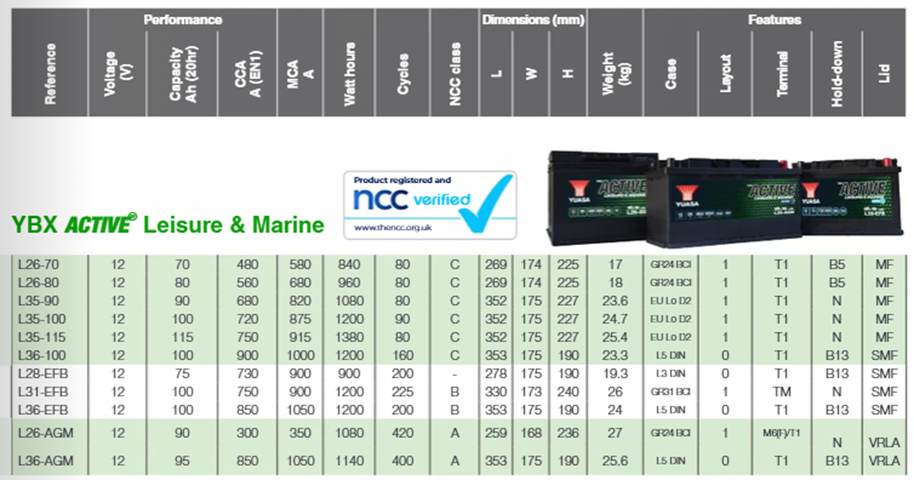What is NCC Verification?
The NCC’s Verified Leisure Battery Scheme ensures it is easy to identify which batteries on the market are quoting accurate, verified specifications.
NCC verification provides confidence that the battery is fit for purpose and will perform as advertised.
All verified batteries are put through comprehensive testing by suitably certified and audited test houses.
Once verified, batteries are graded depending on their capacity, cyclic life and intended purpose.
All Yuasa Batteries are NCC verified.
Class A – AGM
Class B – EFB
Class C – Conventional Flooded

How to choose the correct Leisure Battery?
The below table is a simple and accurate way to choose the correct spec of Leisure battery needed based on certain requirements.
As a rule of thumb, if it is a caravan, a good question to ask is are there any motor movers? (A motor mover is a device used to help move a caravan by using a small electric motor.) If x1 motor mover, the minimum spec required would be an EFB (B Class) if x2 motor movers then an AGM (A Class) would be the minimum spec required.
Other questions to ask would be what is the berth, break length, frequency and off grid use.
As with car batteries you can always up spec but should never down spec based on price!

But you just want the highest Ah capacity battery
It is a common misconception that the Ah capacity of a battery is the most important thing when choosing the correct Leisure battery. Incorrect! The technology inside the battery is far more important and an AGM/EFB battery with a slightly lower Ah capacity will be able to withstand more use than a conventional flooded battery with a higher Ah capacity for a few reasons….
EFB and AGM utilise the latest in next generation battery technology to provide greater endurance, giving more available cycles and faster charging. AGM also offers maximum safety with spill proof internal construction (a must if the battery is located inside the cabin.)
But what is a cycle? The number of times the battery can be discharged to 50% then fully recharged. The higher the cyclic life, the more work the battery can do during its life in service.
Below is a guide to how many cycles each battery will perform (a good way to explain to customers they will be getting more from a higher-class battery, getting away from the “Ah Capacity” conversation)
Class A – AGM – 400-420 Cycles
Class B – EFB – 200-225 Cycles
Class C – Conventional Flooded – 80-160 Cycles
I now know about cycles but what capacity battery do I need?
When operating off-grid with no external power supply the battery supports all electrical loads. The more electrical equipment that is in use, the greater the demand on the battery and the faster it discharges. It is therefore advisable that the battery capacity required for an application is accurately calculated considering the appliances on board, their hourly power consumption, and how long each appliance is likely to be used.
To do this we need to understand the total amount of Watt hours (Wh) all of the electrical equipment on the vehicle will use when switched on and specify the battery accordingly. More electrical equipment used more often will need more Wh.
An example of how Watt hours are calculated could be:
TV rated at 80 Watts on for 2 hours takes 80 x 2 = 160-Watt hours
5 lamps rated at 20 Watts for 4 hours takes 4 x 20 x 4 = 320-Watt hours
Water pump rated at 50 Watts for ½ hour takes 0.5 x 50 =25-Watt hours
Mobile device charging rated 25 Watts for 3 hours takes 3 x 25 = 75-Watt hours.
This gives a total of 580-Watt hours. It is then advisable to factor in a 20% safety margin as the figures used for the capacity calculation can go up or down.
Total battery requirement is therefore 696-Watt hours. The required battery capacity will also be dramatically affected if using a motor mover or auto-levelling system as these consume large amounts of power over a very short time.
All GS Yuasa leisure batteries feature a watt hour rating and guidance on usage type on their label.
Sizing the correct battery
A leisure battery’s size will be limited by the amount of room physically available in the caravan or motorhome’s locker and tray.
Be sure to select a battery that will fit the space. The below chart will give you height dimensions which is a good refence tool. In general, there are lower height versions that will fit most places, battery boxes, under the floor, under seating, where height can be restricted.

For all of your Leisure Battery needs, visit https://www.apd.co.uk/batteries/leisure-batteries for great prices and prompt delivery.
